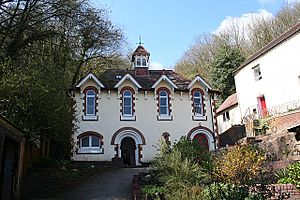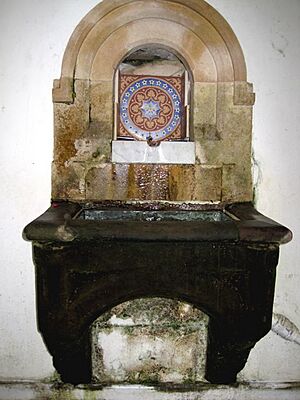Holy Well, Malvern facts for kids
The Holy Well is a famous spring located on the side of the Malvern Hills in England. It's near a village called Malvern Wells. People believe this well is home to the oldest water bottling factory in the world! This is where Malvern spring water was first bottled for sale. Today, the building still has a modern bottling plant inside.
History of the Holy Well
The Holy Well spring has a long and interesting history. In 1559, a man named John Hornyold bought the land where the spring is located.
Years later, in 1743, a doctor named Dr. John Wall studied the spring water. He said the water was very pure and contained "nothing at all" special, which meant it was very clean.
In 1747, a man named Edward Popham felt much better after visiting the Holy Well. He had a condition called gout. To say thank you, he built a small bath at the well.
Later, in 1853, Thomas Charles Hornyold bought the Holy Well and a nearby cottage. He spent a lot of money to make the building bigger. This building held the baths and spa for visitors.
The Holy Well building is considered very important. In the 1970s, it was officially listed as a Grade II building. This means it has special architectural interest.
Bottling Malvern Water
Malvern water has been bottled and sold for a very long time. People were bottling it as early as the 1600s, during the time of King James I. Records show water was bottled at the Holy Well in 1622.
In the 1800s, many local shops bottled and sold Malvern water. But it was a company called Schweppes that started bottling it on a large scale. They opened a big bottling plant at the Holy Well in 1850.
Schweppes even introduced the water at the Great Exhibition in 1851. They first called it Malvern Soda, then Malvern Seltzer Water.
In 1890, Schweppes moved their bottling operations. They built a new plant in a different village. After that, John and Henry Cuff leased the Holy Well. They continued bottling water there until the 1960s.
The Holy Well then became unused for a while. But in 2009, with help from a special grant, a family-owned company started bottling water there again. They now produce about 1200 bottles of Holy Well Spring Water every day!
Folklore and Traditions
The Holy Well has many interesting stories and traditions. In the past, people who were cured at the well would "dress" it on St. Oswald's day. This means they would decorate it.
It is said that St. Oswald told a hermit (someone who lives alone) about the healing powers of the well.
For many years, people would leave small gifts at the Holy Well. These were called votive offerings. They included religious items, flowers, and other objects. People from different faiths would leave prayers and wishes to thank the well for its pure water.
However, in 2006, some concerns were raised. People had written religious messages on the walls of the building. Because of this, most offerings are now regularly removed. The only exception is during the official well dressing event in May.
A writer named Alfred Watkins had an interesting idea about the Holy Well. He thought that a special invisible line, called a ley line, passed through the Malvern Hills. He believed this line connected several wells, including the Holy Well.




